Only about 3.5 percent of commercial and industrial buildings in the United States have solar panels on their roofs. Fully utilizing the 96.5 percent of unused roof space has the potential to add ~145 gigawatts (GW) of solar generating capacity, nearly double the country’s current total, which is roughly the equivalent of more than one hundred coal-fired power plants! Just look outside your window on your next airplane take-off or landing – most rooftops are empty.
Unused roof space equates to significant market opportunity as companies realize the new economics of Commercial and Industrial (C&I) rooftop solar systems. Businesses require both a strong financial return on investment (ROI) and increasingly, a return on carbon (ROC) to validate their investment in clean energy. Historically, the economics for C&I solar were challenging, but the combination of policy change, technology innovation, and creative financing present new and attractive investment opportunities. Today – corporate fiduciaries no longer have to choose between decarbonizing their operations and generating economic value for their shareholders.
In 2022, U.S. companies installed over 1.5 GW of new solar systems to power C&I facilities – compared to just over 1 GW of new installed capacity in 2015. These investments, led by some of the largest U.S.-based corporations, demonstrate increasing awareness of the C&I solar market opportunity. Huge opportunities still remain across manufacturing facilities, shopping malls, office buildings, distribution centers and brick-and-mortar assets. Some organizations, like self-storage company Public Storage, are even hosting community solar projects on its roofs, providing clean energy to the local grid and its customers.
The core benefits of commercial and industrial solar are three-fold:
Financial Return
Onsite generation has the potential to reduce monthly energy bills over the life of the solar asset while also creating opportunities for new business models. The financial return can multiply when paired with federal, state, local, and utility-based incentives.
Decarbonization
Onsite solar generates clean, verifiable electrons. There’s no reliance on your utility to continue to decarbonize, or reliance on mechanisms like renewable energy certificates (RECs) to reduce Scope 2 Greenhouse Gas (GHGs) emissions.
Adaptation and Resilience
Onsite solar (especially when paired with storage solutions) can provide community and resilience benefits in response to extreme climate-related events that threaten electricity availability and reliability. Transmission lines are prone to damage during extreme weather. Wildfires, snow, ice, and wind can damage above-ground power lines and transmission towers. Climate-related events can also lead to spikes in energy demand that can overwhelm available supply and cause brownouts and blackouts. Recent estimates of economic losses due to weather and climate disasters topped $1 billion in 2022, and nearly $2.5 trillion since the NOAA National Centers for Environmental Information (NCEI) began tracking this data in 1980.
The recent acceleration of solar energy in the U.S. is driven by market, technology, and policy-related factors
So why is now the right time to develop a holistic strategy around onsite solar for your business? The economics, technology and policy environment are better than ever.
The market for solar has matured over the last fifteen years and in fact, solar has continued to expand in importance as an electric generating source in the United States. In 2010, photovoltaic solar comprised ~4% of total annual net-new additions of electricity generating capacity. That increased to 25% in 2015, and in the first half of 2023 – we saw solar make up 45% of all new electricity-generating capacity. That’s more than any other electric generating source: wind, natural gas, or coal!
But what’s driving this consistent and rapid rise in solar energy generating capacity across the United States? One primary driver is the cost of photovoltaic solar (PV) systems. Average PV system prices ($ / Watt) for commercial solar have dropped by nearly 75% between 2010 and 2022, from an average of $6.00 / Watt to ~$1.50 / Watt in 2022. These declines in price are driven largely by PV module efficiencies as well as hardware and inverter cost declines. The significant cost declines in module prices, 85% according to the National Renewable Energy Laboratory (NREL), have made the ROI of commercial solar increasingly attractive. This shows in the number of commercial installations, estimated to be ~17,000 total installed solar capacity (MWdc) across the U.S., compared to just ~1,000 MWdc in 2010 and ~6,000 MWdc in 2015.
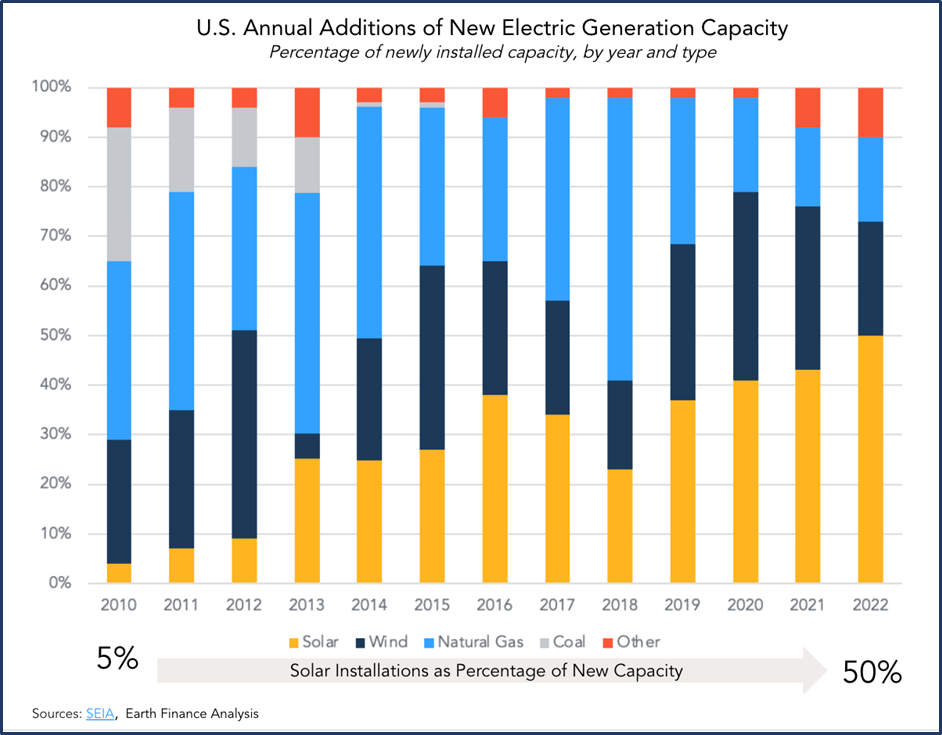
Technology improvements also played a significant role in expanding solar electric generating capacity and in improving its potential for financial ROI. Module efficiencies have improved as technologies have developed, with monocrystalline PV module efficiency pushing beyond a 20% efficiency rate, well above the <15% range that characterized the 2000’s and early 2010’s, while thin-film efficiency continues to improve. These advances in monocrystalline PV modules expand the capabilities, space-efficiency, and lifespan which have made them a go-to choice for commercial PV installations. Market participants like Solar Frontier continue to innovate, recently achieving thin-film efficiency in the lab of 23.3%. The rapid development of newer PV technologies like thin-film also reduce the barriers for commercial solar deployment, as this lighter technology places less of a strain on existing rooftops and opens up the number of locations that could be suitable for rooftop solar without any additional investments in shoring up existing rooftops and structures.
The IRA Creates a Clear Energy Policy Signal for the United States
The passage of the Inflation Reduction Act (H.R. 5376) in August 2022 created federal incentives for renewable energy investments and production, creating the policy certainty from the federal government that investors and corporates had long been waiting for. Some researchers estimate that the U.S. Inflation Reduction Act of 2022 (IRA) will unlock more than $3 trillion in private sector investment of clean energy generation, transmission, storage, electric vehicle (EV) tax credits, and more over the next decade. The IRA subsidizes corporate onsite solar in the form of tax credits and creates at least 10 years of policy certainty, with many of the tax benefits and incentives effective through at least December 2032.
Four specific elements of the IRA greatly increase the attractiveness of the financial ROI of onsite solar:
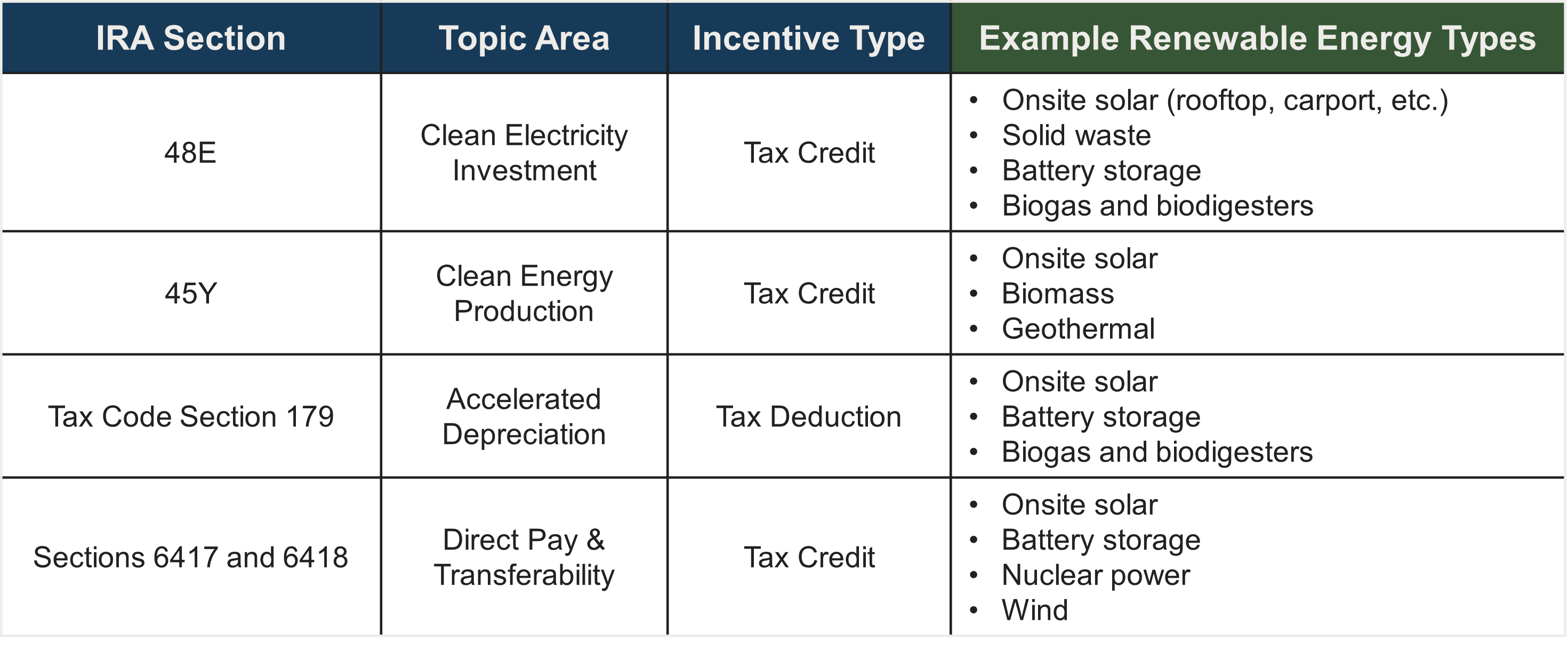
1. Clean Electricity Investment Tax Credit (48E)
The IRA created a tech-neutral, emissions-based investment tax credit (ITC), which consists of a base credit and “bonus” tax credits based on certain requirements.
- Base ITC credit of 30% of the investment in the year the facility is placed into service
- Bonus 10% credit for projects located in energy communities (defined as brownfield sites or fossil fuel communities).
- An easy-to-use map from the Department of Energy which identifies if your facility is located in an energy community can be found here.
- Bonus 10% credit for meeting domestic manufacturing requirements for steel, iron, or manufactured components.
- Bonus 10% credit for projects located in low-income communities or on Tribal land.
- This bonus credit expands to 20% for projects located in low-income residential buildings or which are part of low-income economic benefit projects.
Here’s an example. Your company is considering a $1,000,000 investment in rooftop solar for your distribution facility. Assuming the project meets wage and apprenticeship requirements, you can expect to receive a 30% tax credit in the year the system is placed in service. Let’s also assume your distribution facility is located in a Department of Energy-defined Energy Community, adding another 10% tax credit on top of the base credit. Furthermore, let’s assume you’ve confirmed with your project developer that you will meet the domestic manufacturing requirements for relevant system components, adding another 10% tax credit to the system. Before even considering the energy savings from the solar system or the depreciation-related benefits, your company would be eligible to receive a $500,000 tax credit (meaning a $500,000 reduction of federal tax liability) the year the system is placed in service.
Right now, there are still a few caveats and unknowns - including the specificity around the underlying “wage and apprenticeship” requirements to receive the 30% base credit (developed to ensure that prevailing wages are met for the work in the locality in which it is performed and that a certain percentage of total labor hours is performed by qualified apprentices), as well as how quickly the industry can respond to satisfy the domestic content manufacturing requirements. While we wait for a few of those questions to be answered in the coming months, it’s clear that a 30% to 70% tax credit, which represents a dollar-for-dollar reduction in federal taxes owed, will drastically change the economics of onsite solar investments.
2. New Clean Electricity Production Tax Credit (45Y)
In addition to an extension of the existing Renewable Electricity Production Tax Credit through the end of 2024, the IRA established an emissions-based Production Tax Credit (PTC) that is neutral and flexible between clean electricity technologies. The PTC is structured similarly to the ITC – with a base credit and additional “bonus” incentives available should the taxpayer meet certain requirements.
- Base PTC credit of 1.5 cent per kWh of electricity produced and sold or stored at facilities placed into service after 2024 with zero or negative GHG emissions.
- Bonus 10% credit for projects located in energy communities (defined as brownfield sites or fossil fuel communities).
- Bonus 10% credit for meeting domestic manufacturing requirements for steel, iron, or manufactured components.
- Bonus 10% credit for projects located in low-income communities or on Tribal land.
- This bonus credit expands to 20% for projects located in low-income residential buildings or which are part of low-income economic benefit projects.
Facilities may use carbon capture, utilization and storage (CCUS) to reach qualifying zero or negative GHG emissions levels for the PTC credit.
Note: Taxpayers must choose between a PTC (45Y) and ITC (48E). They cannot use both.
3. Bonus Depreciation
The bonus depreciation provisions in the IRA create another layer of added financial benefit for onsite solar investments. In addition to accelerated depreciation on the solar asset (the IRA recommends using 5-Year Modified Accelerated Cost Recovery half-year convention), the IRA also includes “bonus” accelerated depreciation for assets placed in service between 2023 and 2026.
- Bonus deduction of 80% of the depreciable base of the asset if placed in service in 2023.
- Bonus deduction of 60% of the depreciable base of the asset if placed in service in 2024.
- Bonus deduction of 40% of the depreciable base of the asset if placed in service in 2025.
- Bonus deduction of 20% of the depreciable base of the asset if placed in service in 2026.
The bonus accelerated depreciation is a deduction, which means it’s not a dollar-for-dollar reduction of your federal tax liability, but instead an after-tax shield. This is a lucrative additional incentive for those that move quickly to install onsite solar.
4. Credit Transferability and Direct Pay
Dubbed the “hero” of the IRA by some, the IRA establishes transferability and direct pay options for tax credits, including the ITC and PTC listed above (among others). The direct payment for tax credits allows tax-exempt organizations, such as state, local and Tribal governments, non-profits, U.S. territories, rural energy co-ops and others to access tax credits by receiving a direct payment from the U.S. Government in lieu of a reduction in tax liability.
Tax credit transferability, on the other hand, allows taxable entities to monetize tax credits by transferring the credits to other entities in exchange for tax-free immediate funds, so that businesses can take advantage of tax incentives if they do not have sufficient tax liability to fully utilize the credits themselves.
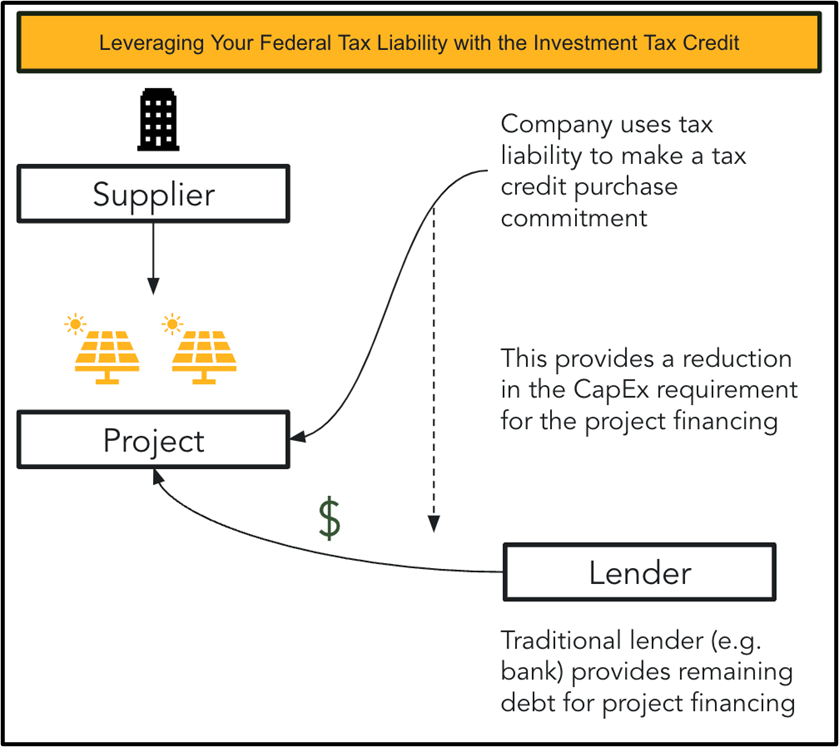
The ability to capture these tax credits is crucial, and the Treasury Department has recently released guidance on key provisions in the IRA regarding the direct pay and transferability requirements of tax credits.
The IRA can be used in conjunction with local, state and utility-level incentives, further adding to the potential financial return on investment of onsite generation opportunities.
Best Practices for Deploying Onsite Solar
Deploying onsite solar is a big decision regardless of the size of your commercial or industrial facilities. It’s potentially capital intensive, long-term in nature (the typical useful life of a commercial solar array ranges from 15 to 25 years), and it can have a major impact on your organization’s decarbonization goals. To make sure you’ve assessed all the financial, energy, and operational impacts to your organization, we recommend the following steps.
Step 1: Assess Your Readiness for Onsite Solar
The first step in deploying onsite solar is understanding your organization’s readiness. This includes:
- An internal assessment of the need for onsite solar, including any climate or clean energy-related commitments
- An evaluation of the skills and capabilities of your team to evaluate and deploy onsite solar
- An understanding of capital available to finance onsite solar as well as alternative financing opportunities potentially available
In addition to an internal assessment of your organization’s readiness, it’s also important to learn from your industry and non-industry peers to avoid “re-inventing the wheel”. By benchmarking peer strategies to evaluate, finance, and deploy onsite solar, you’ll have a clearer picture of the onsite solar strategies and tactics with the highest potential to create long-term strategic, financial, and environmental value.
Step 2: Assess the Project’s Financial, Energy, Carbon Reduction, and Resiliency Potential
Next, you’ll want to assess how onsite solar aligns with your organization’s strategic, financial, and energy-related objectives. Evaluating the financial ROI of onsite solar is a complex task that requires quantitative rigor. Companies must have a deep understanding of energy billing to evaluate the potential energy generation at their facilities, monthly and annual energy savings, as well as the potential tax benefits from the IRA, in addition to any state, local or utility-specific incentives that may be available. Validating the financial ROI is crucial, and so is validating the return on carbon (ROC) of the energy system. Translating energy generation to carbon emission reductions requires detailed calculations that consider the carbon intensity of the energy grid in which your facility is located, as well as projections of the decarbonization potential of the grid over the lifespan of the system. This analysis should occur for your existing sites as well as any planned sites currently being considered or developed. Future sites provide additional flexibility to add battery energy storage systems (BESS), additional hardware and software to create a microgrid, or expand your potential solar footprint from just rooftop to vertical, carport, or other system designs.
The chart below provides an overview of the key inputs companies need to conduct their analysis.
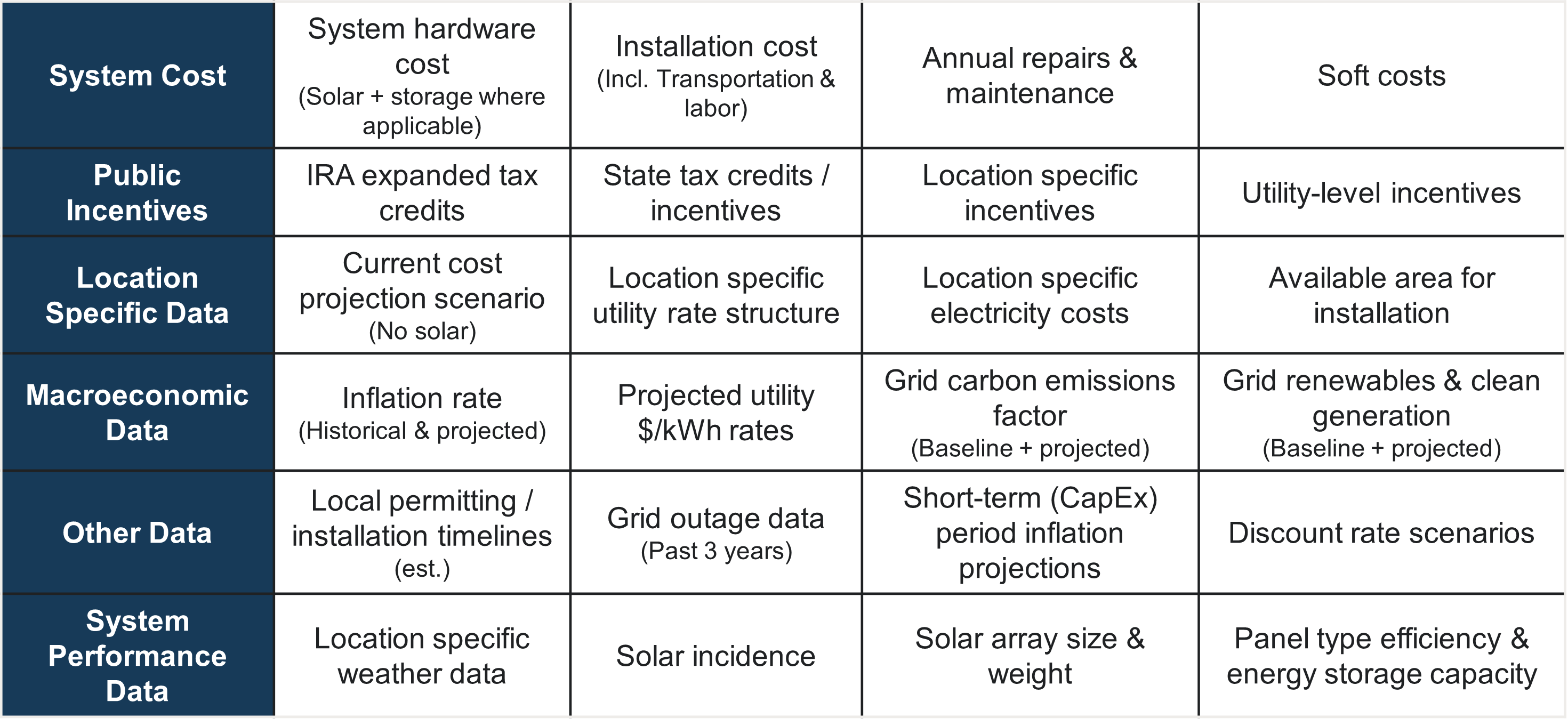
This is also an important time to consider the resilience-related benefits that onsite solar can provide. Investments in onsite solar, along with battery storage and additional hardware investments can create a microgrid that can operate in natural disasters, providing crucial business continuity for your customers and the communities in which you operate during times of need.
Step 3: Develop Your Onsite Solar Strategy
During this stage of the process, you should focus on maximizing the benefits of solar energy while mitigating any financial or operational risks which may exist.
Financing Approach
A number of potential financing approaches exist, and each have different financial, operational, and resilience-related tradeoffs. One financing method is the traditional balance sheet financing model, using cash and / or debt financing to fund the required capital expenditures. This requires high upfront capital costs and provides for full ownership and operational control over the life of the asset.
For organizations not wanting to tie up capital for 15 to 25 years, or for organizations that don’t want to be in charge of operating and maintaining a complex energy generation system, an onsite power purchase agreement (PPA) model may make the most sense. In an onsite PPA, a solar developer makes the upfront capital investment, oversees installation (or does it themselves) and operates and maintains the system during the contract period (typically 15+ years). In return, they sell the energy back to your company at a fixed rate per kilowatt hour. This creates financial predictability over the life of the asset and allows an organization with core capabilities in owning and operating solar arrays to do what they do best while you focus on running your business.
Other financing structures, such as those leveraging a limited liability company (LLC) or hybrid portfolio models allow organizations to more efficiently and effectively deploy solar at scale, but it is best to fully understand the operational considerations and financial benefits of these more complex arrangements prior to implementing.
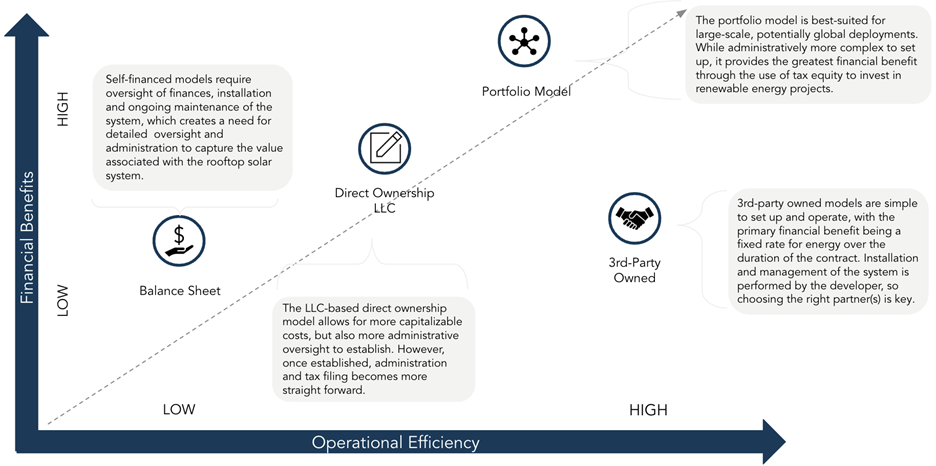
Operational Viability
Evaluating the operational viability of onsite solar is a crucial step before installing a rooftop solar system. The condition of your roof, the physical presence of existing HVAC or refrigeration systems already installed on the roof, and any potential future rooftop needs can all play an important role in determining the size, layout and design of your rooftop solar system.
- Roof Capacity: It’s important to consider the age of the roof on the facility being considered to ensure that it has the capacity to support the solar modules, racking, and mounting which will ultimately be installed. You can work with your architectural engineers to understand any capacity limitations that may exist.
- Roof Access: If your organization has significant amounts of heating, ventilation, cooling, and refrigeration, you should work with your facilities or operations team to understand the existing systems on the roof, what access is required to service and maintain those systems, and how that could impact the design of your solar array.
- Future Needs: Understanding any future expansions in the facility square footage, upcoming renovations, or additions of HVAC and refrigeration systems may impact how your organization evaluates, designs, and installs the rooftop system.
Pilot Program and Roadmap Development
For onsite solar deployments across multiple locations, it’s important to build a pilot program that allows your team to learn as you scale, especially if it’s the first time you’re deploying an onsite solar system. This can start with a pilot program with defined success and learning criteria that span financial, energy, and deployment-related metrics. This can be layered into a broader roadmap that considers time to evaluate sites, contract with vendors, move through permitting, install your system, and ultimately begin generating your own clean energy.
Step 4: Proactively Plan Ongoing Monitoring and Maintenance
A crucial element to the long-term success of an onsite solar system is planning for the ongoing monitoring and maintenance required to maximize system performance over its useful life. Onsite solar is not a set-it-and-forget-it investment. An evaluation of your organization’s current capabilities and expertise, areas where you may need to expand your team, or whether external resources to support key parts of the project lifecycle will be required. There are a range of monitoring & maintenance models to consider, but each should be considered against your organization’s capabilities, your long-term objectives with onsite solar, and the level of involvement desired from your team.
For example, an onsite PPA can be structured to guarantee fixed fees and system performance over the life of the asset, with contractual requirements incentivizing the asset owner to ensure agreed-upon performance of the system. You may also consider outsourcing just the ongoing monitoring and maintenance of your onsite solar assets to service providers that manage performance for portfolios of sites. Lastly, there are technology tools and capabilities to support the ongoing monitoring and maintenance of your system, should you decide to manage it in-house.
There Has Never Been a Better Time to Invest in Onsite Solar
This is a unique and pivotal moment in history – and an ideal time for companies to explore whether investing in onsite solar is right for their business. Photovoltaic technology is advancing rapidly, and the U.S. Government has curated an attractive combination of incentives which improve the ROI of installing onsite solar in the short term. Don’t let the sun set on this massive opportunity.



